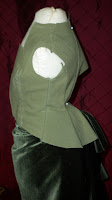As soon as I found out this years DPP was for 1812 I dove into my research. I knew very little about the period- I thought Pride and Prejudice and Jane Austen and that was it. It was only after sifting through online museum pieces that I began to fall in love with the simplistic elegance of whitework on muslin.
And then I discovered tambour embroidery, there were so many new things to learn and I knew that I was going to have to work through this project one piece at a time.
I put my dream for a final design down on paper and found my fabric in a tiny craft store in Scotland- 4m of fine white muslin and 4 m of a white silk that’s as fine as spiders web.
 The shift was simple enough, I found a heavier weight cotton- hoping to add a bit of fullness and warmth beneath the muslin gown. I cut it using a period standard shape, with rectangular sleeves and arm gussets with a drawstring neckline.
The shift was simple enough, I found a heavier weight cotton- hoping to add a bit of fullness and warmth beneath the muslin gown. I cut it using a period standard shape, with rectangular sleeves and arm gussets with a drawstring neckline.The next layer of the gown is a fine white cotton muslin. It has a simple rounded neckline with front and back gathering and wrist length sleeves, the skirt is 3 panels wide, gathered to the empire waistline. The focus point of this layer is the whitework tambour embroidered floral design. I spent ages trying to find and develop a design that was both elegant and simple enough for me to complete in my limited time frame. By chance I found a period correct table mounted embroidery frame, and for several weeks I tamboured during any spare time I could find.
 Between embroidering, family, and full time work I went back to my design and realized that I was a good 2m short on my silk- of course I’d fail to notice that it was several inches narrower than my muslin. And being back in Canada the reality was that I wasn’t going to be able to fly back to Scotland for another 2m of fabric… That’s that scrapped right?
Between embroidering, family, and full time work I went back to my design and realized that I was a good 2m short on my silk- of course I’d fail to notice that it was several inches narrower than my muslin. And being back in Canada the reality was that I wasn’t going to be able to fly back to Scotland for another 2m of fabric… That’s that scrapped right?Well 3 days before the deadline I placed my finished muslin gown on the form and felt a good bit disappointed at how it looked, there was nothing special about it and so last minute I decided to frantically pull together a silk over overdress and just get over the fact that it was 6” too short and not the train I had wanted to use it for.
When I put on all the pieces for the first time, did my hair and wrapped a last minute turban I realized just how much I loved this project. I was sad not to be able to take pictures in Bath or around some other lovely regency architecture, but after losing the sun and a trek through a foot of snow to find a nice spot for pictures I am still in love with this dress- and hope you all will too! Thanks for voting, and best of luck to all my fellow competitors!


















































